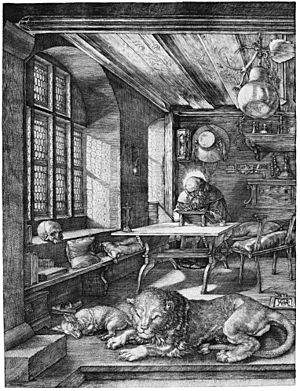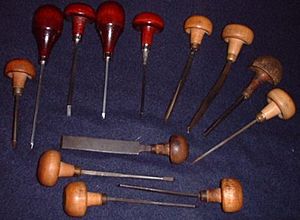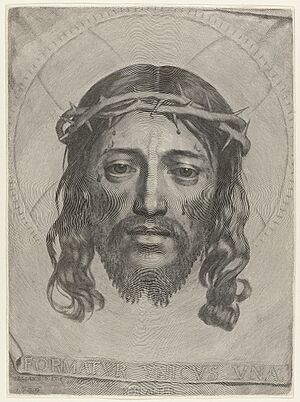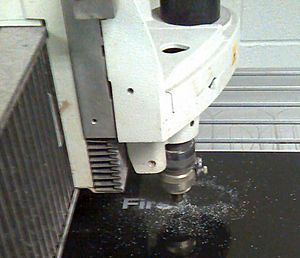Engraving facts for kids

Engraving is a special way of making designs on a hard, flat surface. It involves carving into the surface. The finished piece can be a beautiful decoration, like engraved silver, gold, or steel. Or, it can be a metal plate, often made of copper, used to print pictures on paper. These printed pictures are also called engravings.
For a long time, engraving was a very important way to create images on paper. It was used for art, like making decorative prints, and also for printing books and magazines. Today, photography has mostly replaced engraving for commercial uses. In printmaking, other methods like etching are now much more common.
How Engraving Works
Engravers use a special steel tool called a burin. This tool helps them cut pictures or patterns into the surface, usually a copper plate. Burins come in many shapes and sizes. Each shape creates a different type of line.
The burin makes a unique line that looks steady and has smooth edges. An "angle tint tool" has a slightly curved tip and is often used in printmaking. "Florentine liners" are flat tools with many lines on them. They are good for working on larger areas. "Flat gravers" are used for carving letters and for engraving musical instruments. "Round gravers" are often used on silver and other hard metals like nickel and steel.
Engraving Through History
In ancient history, the earliest engravings were shallow grooves found on some jewelry made after 1000 B.C.
During the Middle Ages in Europe, goldsmiths used engraving to decorate metal items. People think they started printing copies of their designs to keep a record of them. This led to the idea of engraving copper plates to make art on paper. This began in Germany in the 1430s.
The most important time for engraving was from about 1470 to 1530. Famous artists like Martin Schongauer, Albrecht Dürer, and Lucas van Leiden were masters of this art.
After this period, engraving became less popular. Etching took its place because it was much easier for artists to learn. By the 1800s, most engraving was done for commercial purposes, like making pictures for books.
Before photography was invented, engraving was used to copy other forms of art, such as paintings. Engravings were still common in newspapers and many books until the early 20th century. This was because they were cheap to print.
Sometimes, engravers would cross two sets of parallel lines to make an area darker. This pattern was called cross-hatching. Claude Mellan was famous for using lines of different thicknesses. For example, in his work Sudarium of Saint Veronica, he created the face of Jesus using just one spiraling line that starts at the tip of Jesus's nose.
Engraving Today
Because master engravers can create very detailed designs, it's almost impossible to copy their work perfectly. This is why modern banknotes (paper money) are almost always engraved. Plates for printing money, checks, and other important documents are also engraved to prevent them from being faked. The details in hand-engraved images are so fine that a normal printer cannot reproduce them correctly.
In places like the U.S. Bureau of Engraving and Printing, more than one engraver works on the same printing plate. This makes it nearly impossible for anyone to copy all the engraving on a banknote or document.
Many classic postage stamps were engraved. While it's less common now, some countries still use engraving when they want a more "elegant" design and don't need many different colors.
Modern engraving machines, like the K500 or K6 by Hell Gravure Systems, use a diamond "pen" to cut tiny cells. Each cell later creates one printing dot. A K6 machine can have up to 18 engraving heads. Each head can cut 8,000 cells per second with amazing accuracy. These machines are fully controlled by computers, and the whole process of making printing cylinders is automatic.
Using diamonds for engraving has been a top method since the 1960s. Even with new laser engraving machines being developed, mechanical cutting still works well and is cost-effective. More than 4,000 engravers worldwide make about 8 million printing cylinders each year.
Images for kids
-
At an engraver's workshop: Miniature engraving on a Louis George watch movement. This small engraving of the royal Prussian eagle takes about 100 passes to create.
-
Battle of Engravers, a funny etching by George Cruikshank. It shows a pretend battle between famous engravers like William Hogarth, Antoine Masson, William Woollett, Jean-Joseph Balechou, Albrecht Dürer, and Marcantonio Raimondi.
-
Don Quixote engraving by Paul Gustave Doré
See also
 In Spanish: Grabado para niños
In Spanish: Grabado para niños















